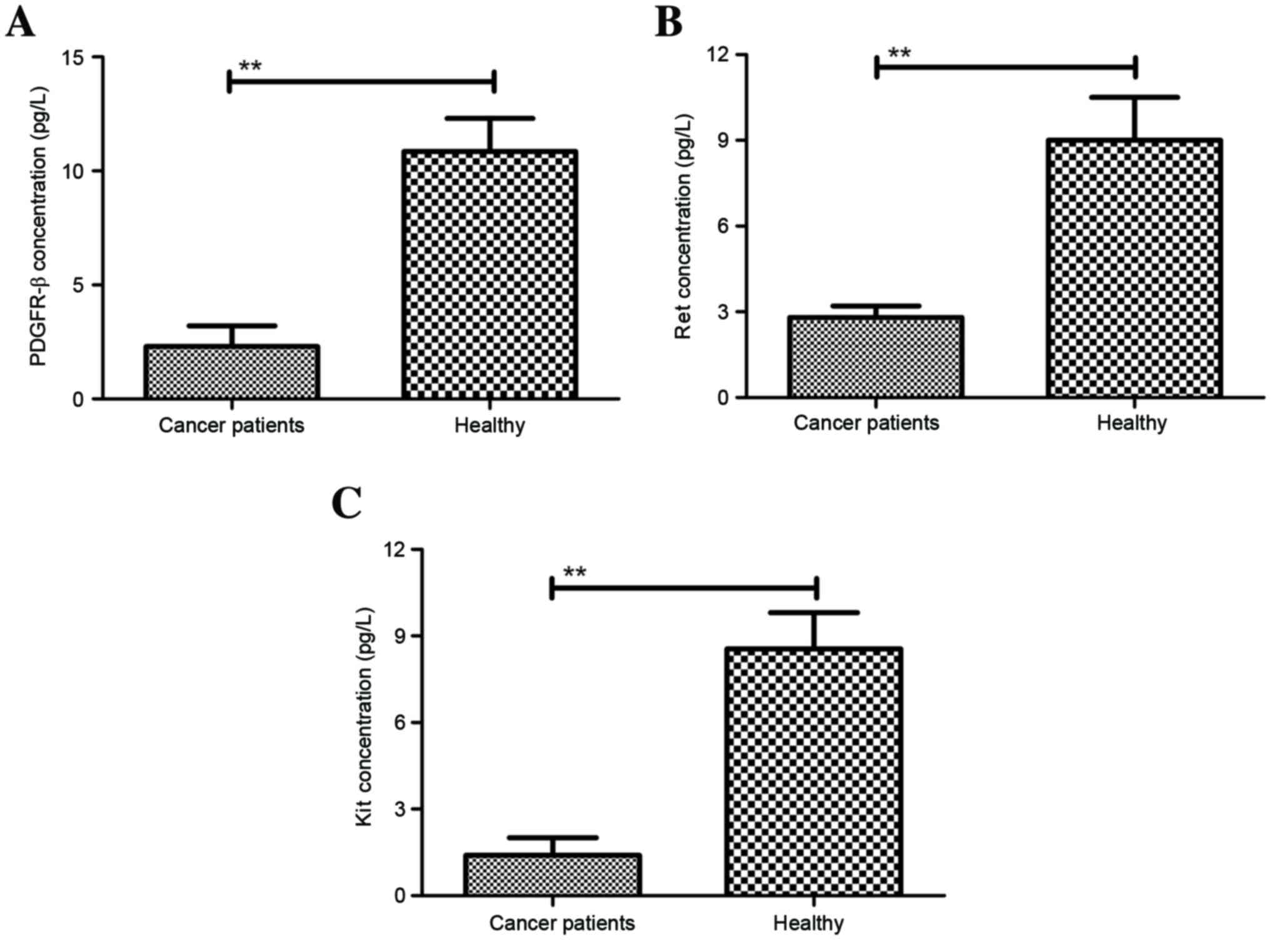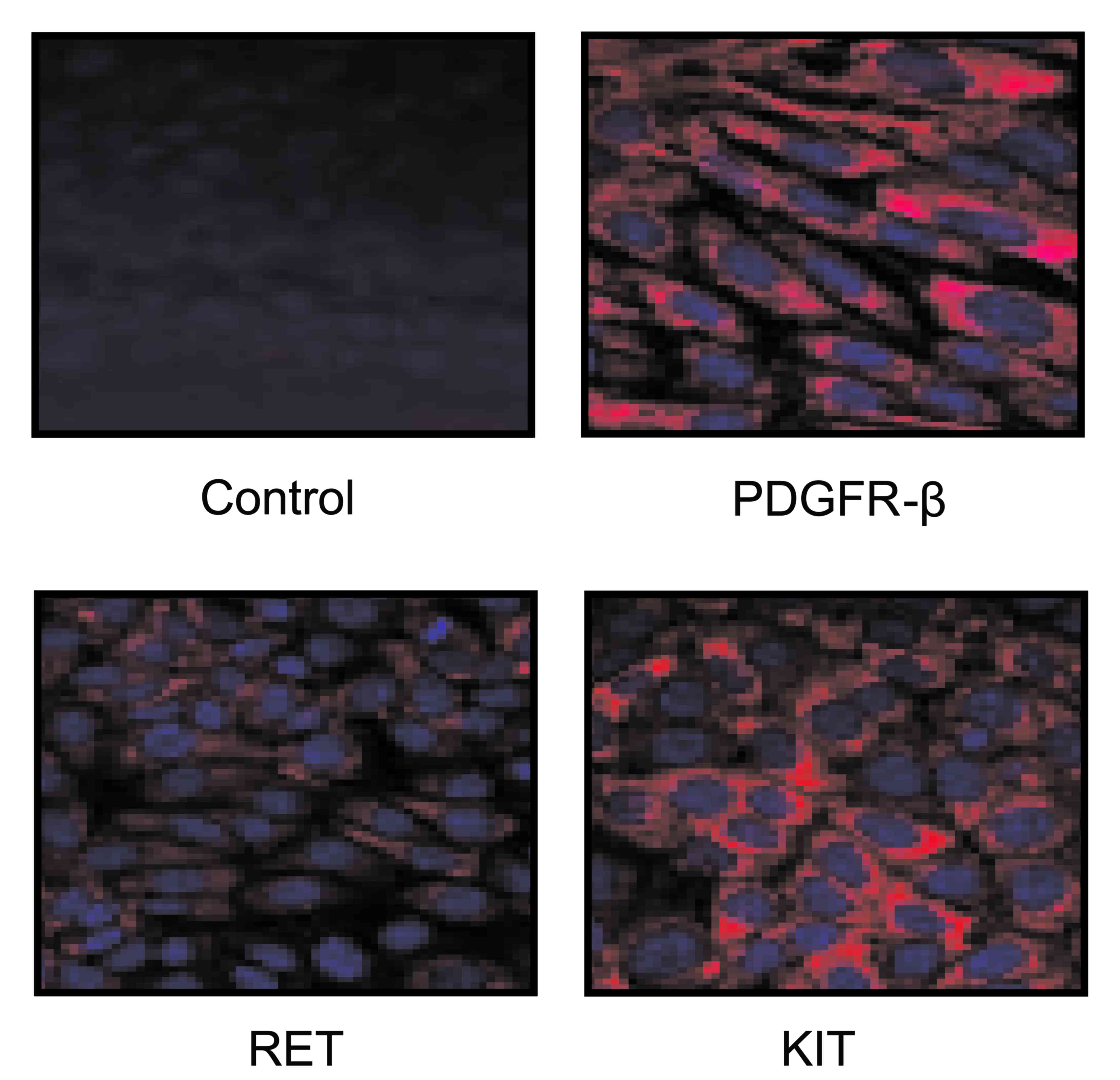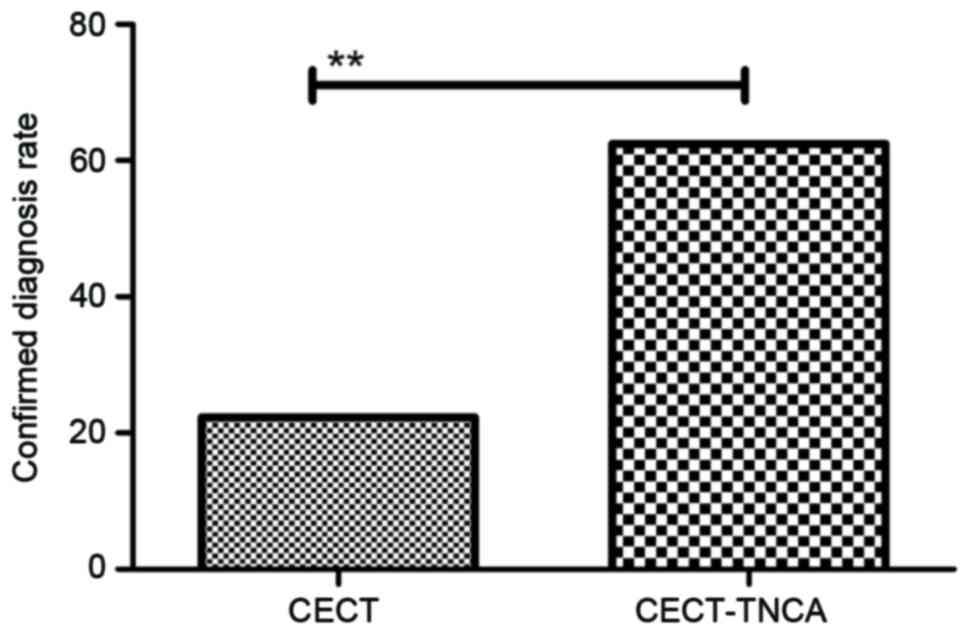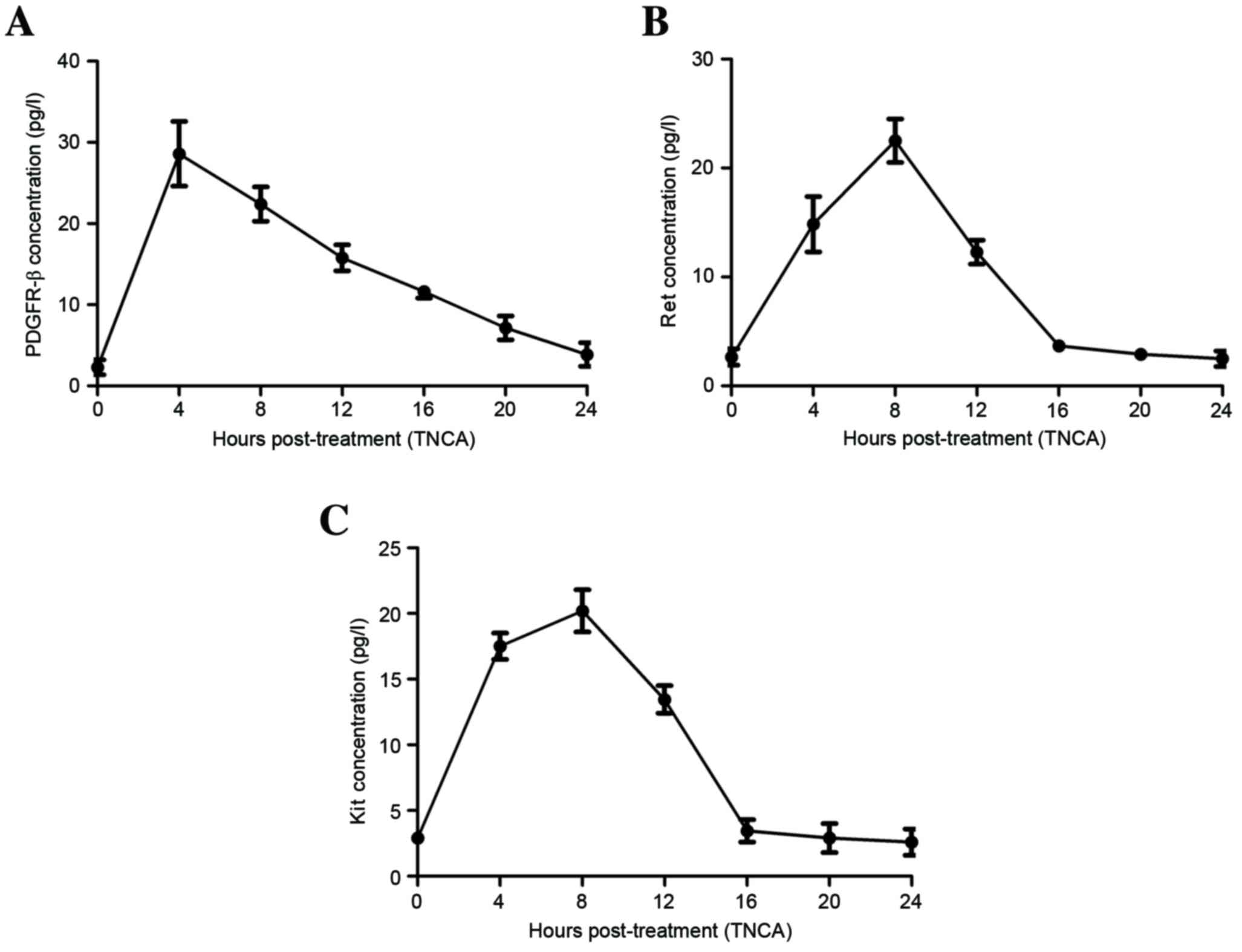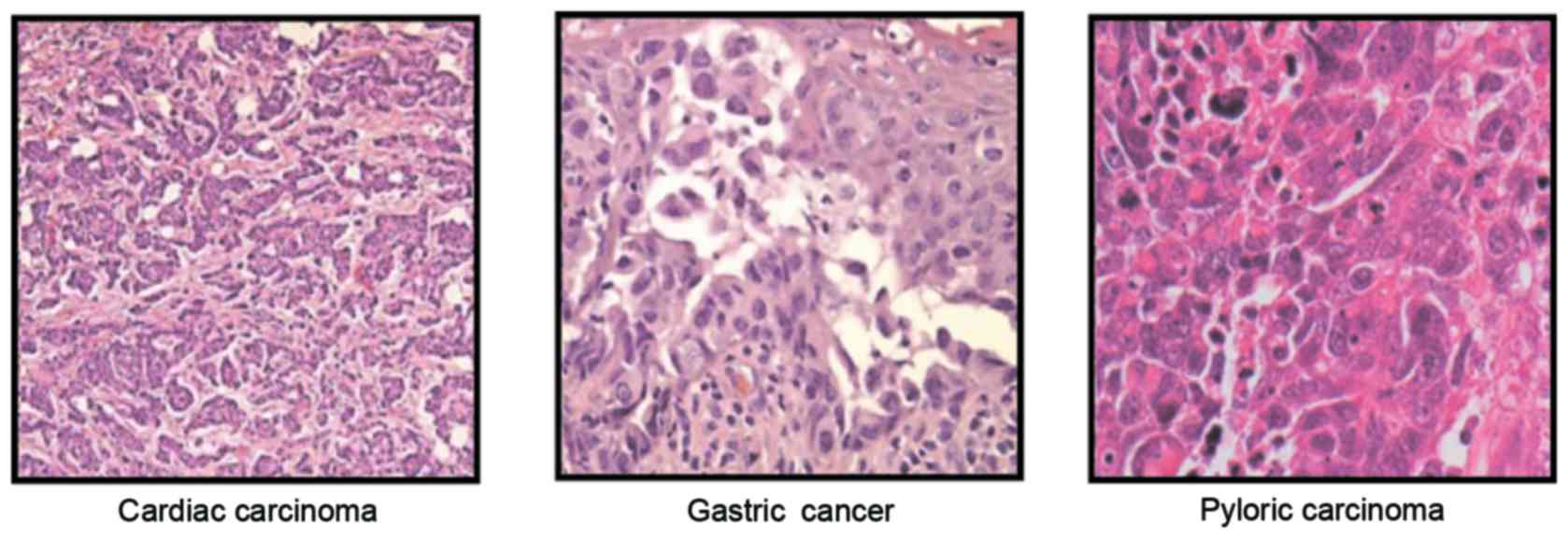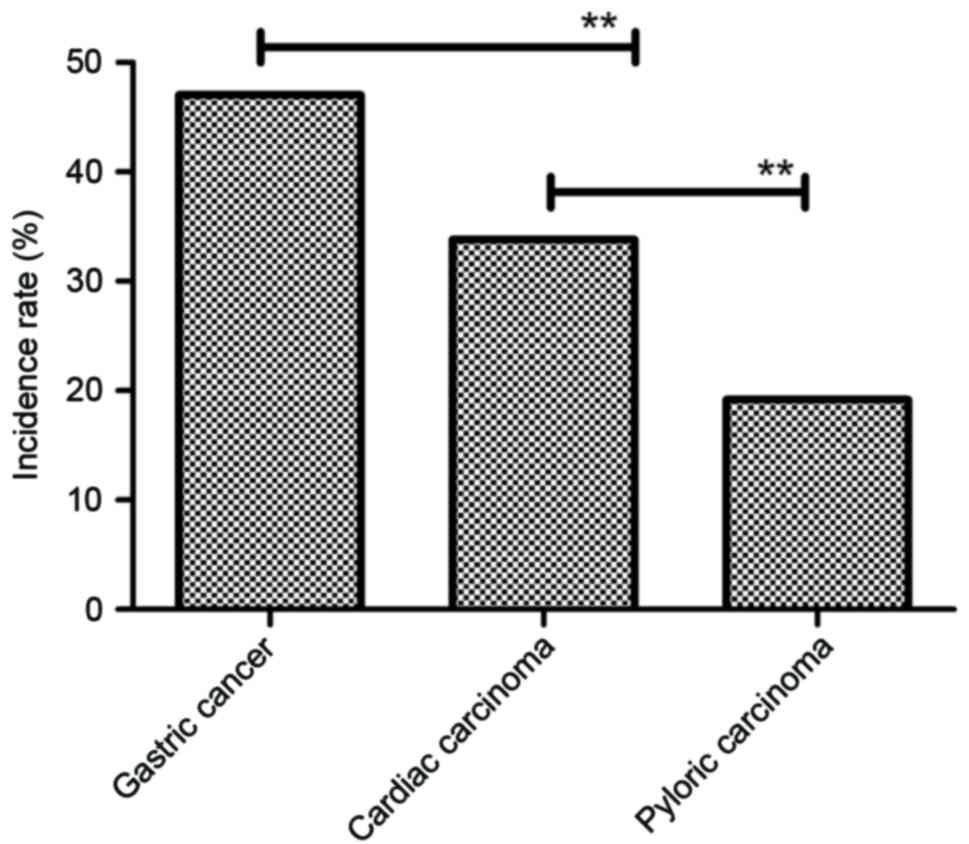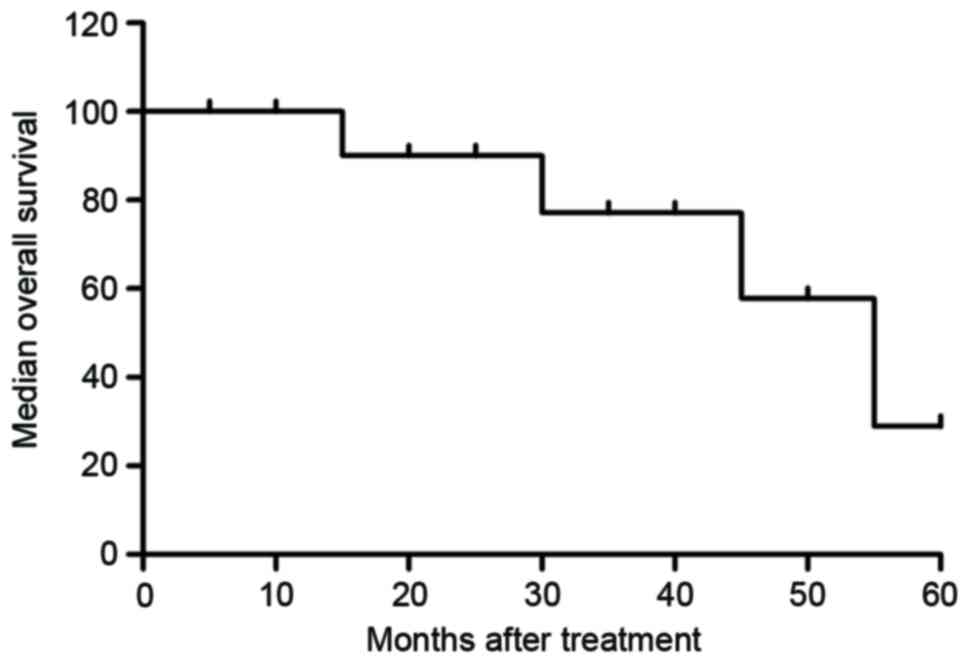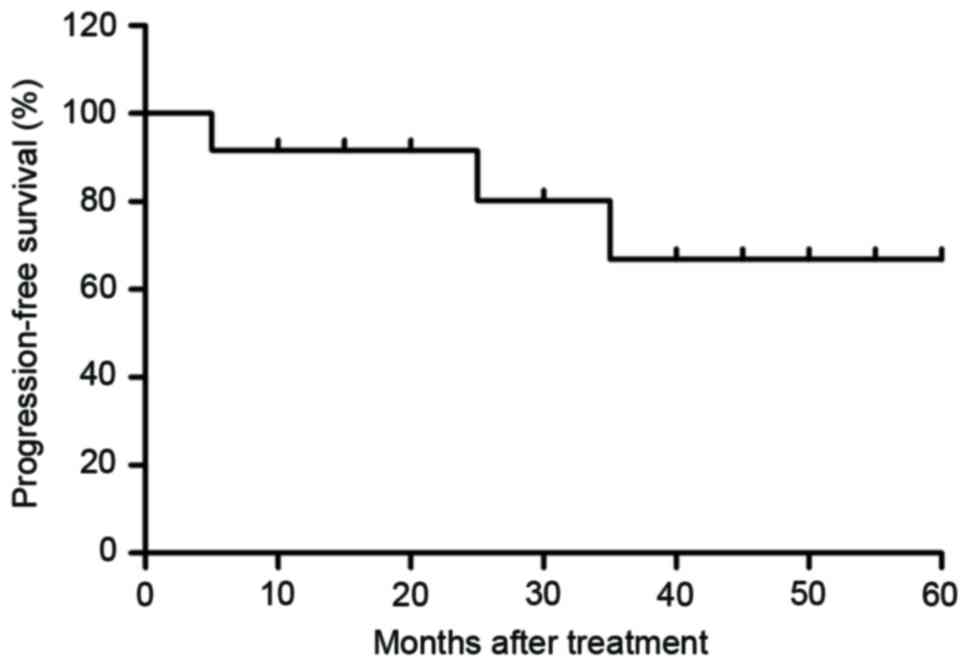Application of novel targeting nanoparticles contrast agent combined with contrast‑enhanced computed tomography during screening for early‑phase gastric carcinoma
- Authors:
- Published online on: October 30, 2017 https://doi.org/10.3892/etm.2017.5388
- Pages: 47-54
-
Copyright: © Zhang et al. This is an open access article distributed under the terms of Creative Commons Attribution License.
Abstract
Introduction
Gastric cancer is one of the most common human epithelial malignancies and remains the second leading cause of cancer-associated mortality for clinical cancer (1). Clinical statistics and investigations have shown that >70% of new cases of gastric cancer-associated deaths occur in developing countries (2,3). Gastric cancer exhibits higher morbidity and mortality rates than other carcinoma derived from the digestive system as gastric cancer is more invasive (4,5). A previous study has indicated that the five-year survival rate for gastric cancer is <80% (6).
Currently, the majority of clinical patients with gastric cancer are categorized as having an advanced stage once diagnosed. In addition, although reports have shown that apoptosis-resistance of gastric cancer is inevitable in the development of cancer progression, the apoptotic resistance of gastric cancer cells in patients with gastric cancer has been indicated as the most important hurdle to overcome in clinical treatment (7,8). Furthermore, apoptotic resistance has become the greatest challenge in cancer therapy due to fierce resistance of tumor cells though various types of molecules mechanism (9–11). Although several comprehensive therapies exist that induce apoptosis, which is the most important component of treatment for patients with gastric cancer, the survival rate remains low (12). These previous reports focused on the efficacy of targeted molecular therapies, and the early diagnosis of gastric cancer is often overlooked.
In recent years, contrast-enhanced ultrasound, computed tomography, fl tomography, ont-positron emission, and tomography (FDG-PET) has been widely used in the diagnosis of human cancer (13). Although many advantages of contrast-enhanced ultrasound have been presented, its relatively reduced resolution compared with CT means that it cannot confirm the final diagnosis for patients with suspected gastric cancer (14). However, nanoscale microbubbles have been used to improve the resolution of ultrasound, as they resonate when exposed to ultrasound waves (14,15). In addition, computerized tomography and chip technology are the most common methods used to diagnose patients with suspected cancer (16). However, the efficacy of single computerized tomography is limited to diagnosing patients with early phase tumors. Furthermore, contrast agent combined with CT for the analysis of tumor biology has been studied and achieved adequate efficacy (17). Therefore, we hypothesized that specific-targeted nanoscale microbubbles may contribute to the efficacy and resolution of CT in the diagnosis of patients with suspected gastric cancer.
In the present study, CECT combined with targeting nanoscale microbubble contrast agent (CECT-TNCA) was introduced to detect the early stage of patients with suspected gastric cancer. Notably, CECT in conjunction with ultrasound contrast further expanded its application in the field of primary diagnosis and confirmed diagnosis (18). This clinical analysis demonstrated the potential application of CECT-TNCA for imaging modality and sensitivity improvements in the diagnosis of gastric cancer. Our outcomes indicated many advantages of CECT-TNCA in both early diagnosis and final confirmation of suspected cases when compared to single CT detection.
Materials and methods
Ethics statement
The design of this clinical study was carried out in strict accordance with the approval and recommendations in the Guide for the Care and Use of clinical study of Xianning Central Hospital (XNCH: 20091108A4). All surgery and euthanasia protocols were standardized. All patients provided written informed consent.
Patients
A total of 484 patients with suspected gastric cancer aged 14.8–65.2 years were recruited for this prospective analysis, in which the follow-up period was 60 months. The number of male (222) and female (264) patients was approximately equal. Furthermore, 236 healthy subjects (male, 124; female, 112) aged 24.0–62.6 years were recruited. Biochemical parameters of patients with suspected NSCLC and healthy subjects recruited between May 2012 and June 2015 were eligible for further analysis. All patients were subjected to scanning for the detection of early-stage gastric cancer by CECT and CECT-TNCA. All healthy subjects had no cancer history or gastric diseases. Patients with cancer history were excluded in the present study.
Nanoparticles contrast agent
A novel liposome-encapsulated nanoparticles contrast agent containing multiple targets was introduced for diagnosing patients with early-stage gastric cancer. Platelet-derived growth factor receptor-β (PDGFR-β), Ret, and Kit bound with the nanoparticles of superparamagnetic iron oxide particles via covalent bonds described in a previous study (19). Nanoparticles contrast agent and Optison (GE Healthcare, Chicago, IL, USA) were orally administered to ensure that they covered each corner of the stomach prior to CECT and CECT-TNCA (30 min). Following administration with CECT-TNCA, the TNCA was distributed in the stomach. Microbubbles contained targeting nanoparticles contrast agent with the capacity to target travelling tumor cells, which acted as an accurate tracer for tumor cells (20). TNCA was located in the lesion following administration with CECT-TNCA. After 30 min, the TNCA was visualized via CECT. No side effects were observed in patients exposed to TNCA.
Scan protocol
A CECT diagnosis system was used to analyze CECT clinical trials using preprogrammed settings. Preprogrammed settings were optimized to achieve optimal image formation. CECT was performed on the stomachs of all patients according to manufacturers instructions (Philips Medical Systems, Inc., Bothell, WA, USA). Details of the principles and settings of contrast-enhanced ultrasound were described in a previous study (21). In addition, CECT-TNCA imaging was performed in all patients with suspected gastric cancer.
Data analysis
Data from CECT-TNCA image sets was analyzed using the ADMIRE CECT system (version 3.10; Siemens Healthineers, Erlangen, Germany). Volume of tumors was measured by CECT-TNCA imaging. All patients with suspected early stage gastric cancer were analyzed by CECT-TNCA and CT. Gastric tumor nodules were observed and tumor size was automatically calculated using Sante CT Viewer (version 2.0; Santesoft, Ltd., Athens, Greece).
Treatment of patients with gastric cancer diagnosed by CECT-TNCA
Patients with early stage gastric cancer diagnosed by CECT-TNCA received various different treatments including radiotherapy (n=39), chemotherapy (n=49), Chinese medicine (n=58), biological therapy (n=35), and comprehensive therapy (n=53). Median overall survival and median progression-free survival were analyzed as previously described (22).
Immunofluorescence and histological staining
Following diagnostic confirmation via CECT-TNCA, tumor cells from patients with gastric cancer were cultured in vitro with Dulbecco's modified Eagle's medium supplemented with 10% heat-inactivated FBS (Invitrogen; Thermo Fisher Scientific, Inc., Waltham, MA, USA). Gastric tumors cells (1×106 cells/ml) were incubated with TNCA for 30 min at 37°C. Cells were observed under a fluorescence microscope. Immunofluorescence procedures were previously reported in detail (23). For histological staining, tumor sections were stained with hematoxylin and eosin staining as previously reported (24).
Statistical analysis
All data were presented as the mean and standard deviation of triplicate experiments. Unpaired data was determined by Student's t-test and comparisons of data between multiple groups were analyzed by variance. Kaplan-Meier was used to estimate the survival rate during 60-month long-term follow-up observations. P<0.05 was considered to indicate a statistically significant difference.
Results
Plasma concentrations of PDGFR-β, Ret, and Kit in patients with suspected gastric cancer
In order to analyze the target characteristic of TNCA, a total of 484 patients with suspected gastric cancer were voluntarily recruited to investigate the efficacy of CECT-TNCA in the diagnosis of patients with early-stage gastric cancer. Characteristics of patients with suspected gastric cancer are summarized in Table I. The dose of TNCA to achieve the optimum efficiency was identified as 15 mg/kg (Table II). In addition, we investigated the plasma concentration of PDGFR-β, Ret, and Kit in patients with suspected gastric cancer. As shown in Fig. 1A, PDGFR-β plasma concentration was significantly lower in patients with gastric cancer when compared with healthy subjects. We also found that plasma concentration of Ret was significantly downregulated in patients with gastric cancer when compared with healthy subjects (Fig. 1B). In addition, compared with healthy subjects, plasma concentration of Kit was significantly lower in patients with gastric cancer (Fig. 1C). Furthermore, clinical analysis also indicated that our novel TNCA containing PDGFR-β, Ret, and Kit adhered to gastric cancer cells, which contributed to the signal strength and resolution (Fig. 2).
Table II.Confirmation of the dosage of targeting nanoparticles contrast agent required for diagnosis. |
Efficacy of CECT-TNCA for the early diagnosis of patients with suspected gastric cancer
As shown in Fig. 3, clinical analysis showed that 182 patients (37.6%) were diagnosed as tumor-free and 302 patients (62.4%) were identified as having gastric cancer, as determined by CECT-TNCA. However, the positive rate of patients with gastric cancer was only 22.3% (108 patients) when evaluated via CECT alone. In addition, the investigation found that TNCA increased the plasma concentration of PDGFR-β and metabolized within 24 h (Fig. 4A). Patients who underwent CECT-TNCA exhibited increasing plasma concentrations of Ret that peaked at 12 h and attenuated by 16 h (Fig. 4B). Plasma concentrations of Kit were increased and metabolized within 20 h (Fig. 4C). These clinical data indicated that CECT-TNCA is an efficient diagnostic strategy for the early diagnosis of patients with suspected gastric cancer.
Histopathology analysis of the accuracy of CECT-TNCA-diagnosis patients with gastric cancer. After diagnosing patients with suspected gastric cancer, histopathology analysis was used to further confirm diagnosis. Representative cardiac carcinoma, gastric cancer and pylorus carcinoma incidence rates were studied in the patients who had a confirmed diagnosis of gastric cancer. As shown in Fig. 5, our data showed that histopathology analysis identified cardiac carcinoma, gastric cancer and pyloric carcinoma gastric cancer. The incidence rate of cardiac carcinoma, gastric cancer and pyloric carcinoma was 33.8% (102 cases), 47.0% (142 cases) and 19.2% (58 cases), respectively, in gastric cancer (Fig. 6). These outcomes suggest that the CECT-TNCA method is accurate and sensitive for diagnosing patients with gastric cancer.
Survival rate of patients with gastric cancer diagnosed by CECT-TNCA
Patients with early-phase gastric cancer received different treatments to inhibit tumor cell growth or eradicate gastric cancer. We analyzed the reports of the treatment methods and survival rates of patients with gastric cancer diagnosed by CECT-TNCA. Characteristics of 234 patients with early-phase gastric cancer diagnosed by CECT-TNCA are summarized in Table III. At the 60-month follow-up, we observed that 132 patients (56.4%) were tumor-free and 88 patients (37.6%) had survived and exhibited tumors. The mortality rate was 6.0% (14 patients; Table IV). Median overall survival was 45.8 months (Fig. 7; range, 30.4–63.8 months) and median progression-free survival was 36.8 months (Fig. 8; range, 24.5–52.4 months). These data indicate that patients with early-phase gastric cancer received anti-cancer treatments that prolonged the survival and progression-free survival period, and that that comprehensive therapy had notable therapeutic effects compared with the others treatments.
Discussion
Cancer early diagnosis is the biggest obstacle in human cancer treatment (25,26). In recent years, contrast-enhanced ultrasound, fluorodeoxyglucose-positron emission, tomography (FDG-PET), CECT and chip technology have been widely used in the diagnosis of human cancer (27,28). In particular, CECT and chip technology present more advantages than other diagnostic methods (29,30). However, the application of gene chip technology is restricted due to expensive detection and the professional analysts required (31,32). Therefore, CECT has been become the most prevalent diagnostic method in the majority of hospitals worldwide (33,34).
Though CECT has been widely applied in the diagnosis of human cancer, the accuracy and sensitivity of CECT is insufficient for the detection of early-stage tumors (35,36). Barium sulfate and iodinated contrast media are frequently used for angiography studies and the diagnosis of tumors in the digestive system (37,38). In addition, many electropositive iron and iron oxide nanoparticles are used as contrast media and have been reported to be useful in the diagnosis of human cancer in previous clinical trials (39,40). Furthermore, retroreflective-type Janus microspheres have also been reported as a novel contrast agent for enhanced optical coherence tomography (41). However, these contrast mediums only improve the partial accuracy of CT in a certain degree. Therefore, elucidating more efficient contrast mediums with targeting characteristics has attracted increasing attention from researchers and clinicians in the field of cancer research and clinical therapy.
In the present study, we introduced a comprehensive approach of CECT combined with target nanoparticles contrast agent to improve the accuracy for patients with suspected gastric cancer in the early stage. Target nanoparticles contrast mediums, containing PDGFR-β, Ret, and Kit, were encapsulated by liposome. Our clinical outcomes indicate that liposome-encapsulated TNCA presents a potential tumor-specific approach that may lead to improvements in the diagnostic accuracy of patients with early-stage gastric cancer. Targeted binding of liposome-encapsulated TNCA with gastric tumor cells enhances signal intensity in the lesions of the stomach, resulting in an improvement in the spatial resolution of CECT. Notably, pharmacokinetic tracer kinetics analysis demonstrated that the target nanoparticles contrast mediums of PDGFR-β, Ret, and Kit were metabolized within 24 h. No side effects were noted during the diagnostic period. Long-term follow-up reports showed that patients diagnosed by CECT-TNCA at the early stage present higher median overall survival (30.4–63.8 months) and median progression-free survival (24.5–52.4 months).
Tyrosine kinase inhibitors of PDGFR-β, Ret, and Kit-mediated angiogenesis have been identified as key factors in the development of human cancer (42,43). PDGFR-β, Ret, and Kit have potent anti-tumor activity against a number of human tumors through binding with targets (44). Previous reports have suggested that target receptors of PDGFR-β, Ret, and Kit in gastric tumors are effective treatments (45–47). Although previous contrast media have not previously been compared to determine which media is optimal for the visualization and diagnosis of gastric cancer (48). Indeed, CECT using a different contrast agent enables non-destructive diagnosis of the biochemical and biomechanical properties of patients with various diseases (49). In addition, a previous study has evaluated dynamic CECT imaging in the differentiation of benign and malignant tumors observed by tumor vessel and permeability nodule perfusion (50). However, conventional contrast agents present lower efficacy for tumor analysis due to rapid diffusion outside the lungs, which prevents optimal imaging (51). Furthermore, previous reports have shown that iodinated contrast agents are less sensitive to changes in cells morphology (52,53). Our design showed that liposome-encapsulated target nanoparticles contrast mediums are potential nanoparticles contrast agents that may improve the accuracy of diagnosing early-stage gastric tumors. Targeted binding of target nanoparticles contrast mediums with gastric tumor cells enhanced signal intensity in lesions in stomachs diagnosed by CECT-TNCA.
In conclusion, to the best of our knowledge, this is the first report of liposome-encapsulated targeted nanoparticles contrast mediums combined with CECT for the diagnosis of patients with suspected early stage gastric cancer. CECT-TNCA was administered orally to augment the signal intensity in the stomach, leading to a reliable and sensitive assessment of the tumor for clinical diagnosis in patients with gastric cancer.
References
|
Golpour S, Rafie N, Safavi SM and Miraghajani M: Dietary isoflavones and gastric cancer: A brief review of current studies. J Res Med Sci. 20:893–900. 2015. View Article : Google Scholar : PubMed/NCBI | |
|
Hossain MM and Chen Z: Comments on ‘Application of an adaptive design to a randomized phase II selection trial in gastric cancer: A report of the study design’ by Satoshi Morita and Junichi Sakamoto. Pharmaceutical Statistics. Pharm Stat. 11:267–268. 2012. View Article : Google Scholar : PubMed/NCBI | |
|
Khayatzadeh S, Feizi A, Saneei P and Esmaillzadeh A: Vitamin D intake, serum Vitamin D levels, and risk of gastric cancer: A systematic review and meta-analysis. J Res Med Sci. 20:790–796. 2015. View Article : Google Scholar : PubMed/NCBI | |
|
Pimenta-Melo AR, Monteiro-Soares M, Libânio D and Dinis-Ribeiro M: Missing rate for gastric cancer during upper gastrointestinal endoscopy: A systematic review and meta-analysis. Eur J Gastroenterol Hepatol. 28:1041–1049. 2016. View Article : Google Scholar : PubMed/NCBI | |
|
Veisani Y and Delpisheh A: Survival rate of gastric cancer in Iran; a systematic review and meta-analysis. Gastroenterol Hepatol Bed Bench. 9:78–86. 2016.PubMed/NCBI | |
|
Nakajima T, Inokuchi K, Hattori T, Inoue K, Taguchi T, Kondou T, Abe O, Kikuchi K, Tanabe T and Ogawa N: Multi-institutional cooperative study of adjuvant immunochemotherapy in gastric cancer-five-year survival rate. Gan To Kagaku Ryoho. 16:799–806. 1989.(Article in Japanese). PubMed/NCBI | |
|
Jung SA, Park YM, Hong SW, Moon JH, Shin JS, Lee HR, Ha SH, Lee DH, Kim JH, Kim SM, et al: Cellular inhibitor of apoptosis protein 1 (cIAP1) stability contributes to YM155 resistance in human gastric cancer cells. J Biol Chem. 290:9974–9985. 2015. View Article : Google Scholar : PubMed/NCBI | |
|
Izawa M, Mori T, Satoh T, Teramachi K and Sairenji T: Identification of an alternative form of caspase-9 in human gastric cancer cell lines: A role of a caspase-9 variant in apoptosis resistance. Apoptosis. 4:321–325. 1999. View Article : Google Scholar : PubMed/NCBI | |
|
Moody SE, Schinzel AC, Singh S, Izzo F, Strickland MR, Luo L, Thomas SR, Boehm JS, Kim SY, Wang ZC and Hahn WC: PRKACA mediates resistance to HER2-targeted therapy in breast cancer cells and restores anti-apoptotic signaling. Oncogene. 34:2061–2071. 2015. View Article : Google Scholar : PubMed/NCBI | |
|
Shiota M, Yokomizo A and Naito S: Pro-survival and anti-apoptotic properties of androgen receptor signaling by oxidative stress promote treatment resistance in prostate cancer. Endocr Relat Cancer. 19:R243–R253. 2012. View Article : Google Scholar : PubMed/NCBI | |
|
Yamato I, Sho M, Shimada K, Hotta K, Ueda Y, Yasuda S, Shigi N, Konishi N, Tsujikawa K and Nakajima Y: PCA-1/ALKBH3 contributes to pancreatic cancer by supporting apoptotic resistance and angiogenesis. Cancer Res. 72:4829–4839. 2012. View Article : Google Scholar : PubMed/NCBI | |
|
Kanat O, O'Neil B and Shahda S: Targeted therapy for advanced gastric cancer: A review of current status and future prospects. World J Gastrointest Oncol. 7:401–410. 2015. View Article : Google Scholar : PubMed/NCBI | |
|
Ebell MH, Culp MB and Radke TJ: A systematic review of symptoms for the diagnosis of ovarian cancer. Am J Prev Med. 50:384–394. 2016. View Article : Google Scholar : PubMed/NCBI | |
|
Mazzei MA, Guerrini S, Mazzei FG, Squitieri N Cioffi, Notaro D, de Donato G, Galzerano G, Sacco P, Setacci F, Volterrani L and Setacci C: Follow-up of endovascular aortic aneurysm repair: Preliminary validation of digital tomosynthesis and contrast enhanced ultrasound in detection of medium- to long-term complications. World J Radiol. 8:530–536. 2016. View Article : Google Scholar : PubMed/NCBI | |
|
Schalk SG, Demi L, Bouhouch N, Kuenen MPJ, Postema AW, de la Rosette JJMCH, Wijkstra H, Tjalkens TJ and Mischi M: Contrast-enhanced ultrasound angiogenesis imaging by mutual information analysis for prostate cancer localization. IEEE Trans Biomed Eng. 64:661–670. 2016. View Article : Google Scholar : PubMed/NCBI | |
|
Markic D, Krpina K, Ahel J, et al: Different presentations of renal cell cancer on ultrasound and computerized tomography. Urologia. 81:228–232. 2014. View Article : Google Scholar : PubMed/NCBI | |
|
Shi H, Wang Z, Huang C, Gu X, Jia T, Zhang A, Wu Z, Zhu L, Luo X, Zhao X, et al: A functional CT contrast agent for in vivo imaging of tumor hypoxia. Small. 12:3995–4006. 2016. View Article : Google Scholar : PubMed/NCBI | |
|
Krylova NS, Demkina AE, Poteshkina NG and Khashieva FM: Tissue Doppler imaging and ultrasonic methods for evaluating myocardial deformation in the diagnosis of hypertrophic cardiomyopathy. Kardiologiia. 54:79–84. 2014.(In Russian). View Article : Google Scholar : PubMed/NCBI | |
|
Chen CL, Hu GY, Mei Q, Qiu H, Long GX and Hu GQ: Epidermal growth factor receptor-targeted ultra-small superparamagnetic iron oxide particles for magnetic resonance molecular imaging of lung cancer cells in vitro. Chin Med J (Engl). 125:2322–2328. 2012.PubMed/NCBI | |
|
Shan L: Polyethylene glycol-coated and folic acid-conjugated superparamagnetic iron oxide nanoparticlesMolecular Imaging and Contrast Agent Database (MICAD). Bethesda (MD): 2004 | |
|
Nakamoto Y, Ishimori T, Sano K, Temma T, Ueda M, Saji H and Togashi K: Clinical efficacy of dual-phase scanning using Ga-DOTATOC-PET/CT in the detection of neuroendocrine tumours. Clin Radiol. 71:1069.e1–5. 2016. View Article : Google Scholar | |
|
Angelov KG, Vasileva MB, Grozdev KS, Sokolov MB and Todorov G: Clinical and pathological characteristics, and prognostic factors for gastric cancer survival in 155 patients in Bulgaria. Hepatogastroenterology. 61:2421–2424. 2014.PubMed/NCBI | |
|
Dirani M, Nasreddine W, Abdulla F and Beydoun A: Seizure control and improvement of neurological dysfunction in Lafora disease with perampanel. Epilepsy Behav Case Rep. 2:164–166. 2014. View Article : Google Scholar : PubMed/NCBI | |
|
Kargahi N, Razavi SM, Deyhimi P and Homayouni S: Comparative evaluation of eosinophils in normal mucosa, dysplastic mucosa and oral squamous cell carcinoma with hematoxylin-eosin, Congo red, and EMR1 immunohistochemical staining techniques. Electron Physician. 7:1019–1026. 2015.PubMed/NCBI | |
|
Soler M, Estevez MC, Villar-Vazquez R, Casal JI and Lechuga LM: Label-free nanoplasmonic sensing of tumor-associate autoantibodies for early diagnosis of colorectal cancer. Anal Chim Acta. 930:31–38. 2016. View Article : Google Scholar : PubMed/NCBI | |
|
Hopper AD and Campbell JA: Early diagnosis of oesophageal cancer improves outcomes. Practitioner. 260:23–28, 3. 2016.PubMed/NCBI | |
|
Shah RB, Leandro G, Romerocaces G, Bentley J, Yoon J, Mendrinos S, Tadros Y, Tian W and Lash R: Improvement of Diagnostic Agreement among Pathologists in Resolving an ‘Atypical Glands Suspicious for Cancer’ diagnosis in prostate biopsies utilizing a novel ‘Disease-Focused Diagnostic Review’ quality improvement process. Hum Pathol. 56:155–162. 2016. View Article : Google Scholar : PubMed/NCBI | |
|
Haider MA, Yao X, Loblaw A and Finelli A: Multiparametric magnetic resonance imaging in the diagnosis of prostate cancer: A Systematic Review. Clin Oncol (R Coll Radiol). 28:550–567. 2016. View Article : Google Scholar : PubMed/NCBI | |
|
Chen WG, Yang CM, Xu LH, Zhang N, Liu XY, Ma YG, Huo XL, Han YS, Tian DA and Zheng Y: Gene chip technology used in the detection of HPV infection in esophageal cancer of Kazakh Chinese in Xinjiang Province. J Huazhong Univ Sci Technol Med Sci. 34:343–347. 2014. View Article : Google Scholar : PubMed/NCBI | |
|
Li RZ, Shi JF, Zhou QZ, Wu RF, Li N, Wu LN, Zhou YQ, Wang Q, Liu ZH, Liu B and Qiao YL: Evaluation of gene chip technology for high risk type human papillomavirus in cervical cancer screening. Zhonghua Yi Xue Za Zhi. 86:307–311. 2006.(In Chinese). PubMed/NCBI | |
|
Hampton T: Breast cancer gene chip study under way: Can new technology help predict treatment success? Jama. 291:2927–2930. 2004. View Article : Google Scholar : PubMed/NCBI | |
|
Watson RW: Gene-chip technology and prostate cancer: The identification of new genes regulating tumour progression. BJU Int. 91:3072003. View Article : Google Scholar : PubMed/NCBI | |
|
Kooiman J, Sijpkens YW, de Vries JP, Brulez HF, Hamming JF, van der Molen AJ, Aarts NJ, Cannegieter SC, Putter H, Swarts R, et al: A randomized comparison of 1-h sodium bicarbonate hydration versus standard peri-procedural saline hydration in patients with chronic kidney disease undergoing intravenous contrast-enhanced computerized tomography. Nephrol Dial Transplant. 29:1029–1036. 2014. View Article : Google Scholar : PubMed/NCBI | |
|
Mir MA, Bali BS, Mir RA and Wani H: Assessment of the severity of acute pancreatitis by contrast-enhanced computerized tomography in 350 patients. Ulus Travma Acil Cerrahi Derg. 19:103–108. 2013. View Article : Google Scholar : PubMed/NCBI | |
|
Kakimoto N, Chindasombatjaroen J, Tomita S, Shimamoto H, Uchiyama Y, Hasegawa Y, Kishino M, Murakami S and Furukawa S: Contrast-enhanced multidetector computerized tomography for odontogenic cysts and cystic-appearing tumors of the jaws: Is it useful? Oral Surg Oral Med Oral Pathol Oral Radiol. 115:104–113. 2013. View Article : Google Scholar : PubMed/NCBI | |
|
Freling N, Roele E, Schaefer-Prokop C and Fokkens W: Prediction of deep neck abscesses by contrast-enhanced computerized tomography in 76 clinically suspect consecutive patients. Laryngoscope. 119:1745–1752. 2009. View Article : Google Scholar : PubMed/NCBI | |
|
Konduru N, Keller J, Ma-Hock L, Gröters S, Landsiedel R, Donaghey TC, Brain JD, Wohlleben W and Molina RM: Biokinetics and effects of barium sulfate nanoparticles. Part Fibre Toxicol. 11:552014. View Article : Google Scholar : PubMed/NCBI | |
|
Liss P, Hansell P, Fasching A and Palm F: Iodinated contrast media inhibit oxygen consumption in freshly isolated proximal tubular cells from elderly humans and diabetic rats: Influence of nitric oxide. Ups J Med Sci. 121:12–16. 2016. View Article : Google Scholar : PubMed/NCBI | |
|
Mishra SK, Kumar BS, Khushu S, Tripathi RP and Gangenahalli G: Increased transverse relaxivity in ultrasmall superparamagnetic iron oxide nanoparticles used as MRI contrast agent for biomedical imaging. Contrast Media Mol Imaging. 11:350–361. 2016. View Article : Google Scholar : PubMed/NCBI | |
|
Kitoh Y: 5. Inspection of hepatocellular carcinoma 3-Contrast for the diagnosis of hepatocellular carcinoma: Techniques of image contrast and the choice of MR contrast agent. Nihon Hoshasen Gijutsu Gakkai Zasshi. 72:441–451. 2016.(In Japanese). | |
|
Zhang J, Liu J, Wang LM, Li ZY and Yuan Z: Retroreflective-type Janus microspheres as a novel contrast agent for enhanced optical coherence tomography. J Biophotonics. 10:878–886. 2017. View Article : Google Scholar : PubMed/NCBI | |
|
Rini BI and Atkins MB: Resistance to targeted therapy in renal-cell carcinoma. Lancet Oncol. 10:992–1000. 2009. View Article : Google Scholar : PubMed/NCBI | |
|
Eichelberg C, Junker K, Ljungberg B and Moch H: Diagnostic and prognostic molecular markers for renal cell carcinoma: A critical appraisal of the current state of research and clinical applicability. Eur Urol. 55:851–863. 2009. View Article : Google Scholar : PubMed/NCBI | |
|
Hutson TE: Targeted therapies for the treatment of metastatic renal cell carcinoma: Clinical evidence. Oncologist. 16 Suppl 2:S14–S22. 2011. View Article : Google Scholar | |
|
Pinto RP, Lima FK, Kulkzynski JM and Moreira LF: Expression of P16 and PDGFR-beta in gastric adenocarcinoma. Rev Col Bras Cir. 36:199–203. 2009.(In English, Portuguese). View Article : Google Scholar : PubMed/NCBI | |
|
Zhang F, Tang JM, Wang L, Wu PP and Zhang M: Immunohistochemical detection of RET proto-oncogene product in tumoral and nontumoral mucosae of gastric cancer. Anal Quant Cytopathol Histopathol. 36:128–136. 2014. | |
|
Bdo N Borges, Eda S Santos, Bastos CE, Pinto LC, Anselmo NP, Quaresma JA, Calcagno DQ, Burbano RM and Harada ML: Promoter polymorphisms and methylation of E-cadherin (CDH1) and KIT in gastric cancer patients from northern Brazil. Anticancer Res. 30:2225–2233. 2010.PubMed/NCBI | |
|
Kingston MJ, Perriman DM, Neeman T, Smith PN and Webb AL: Contrast agent comparison for three-dimensional micro-CT angiography: A cadaveric study. Contrast Media Mol Imaging. 11:319–324. 2016. View Article : Google Scholar : PubMed/NCBI | |
|
Lakin BA, Patel H, Holland C, Freedman JD, Shelofsky JS, Snyder BD, Stok KS and Grinstaff MW: Contrast-enhanced CT using a cationic contrast agent enables non-destructive assessment of the biochemical and biomechanical properties of mouse tibial plateau cartilage. J Orthop Res. 34:1130–1138. 2016. View Article : Google Scholar : PubMed/NCBI | |
|
Sudarski S, Henzler T and Schoenberg SO: Post-therapeutic positron emission tomography/computed tomography for early detection of non-small cell lung cancer recurrence. Transl Lung Cancer Res. 2:295–303. 2013.PubMed/NCBI | |
|
Hagberg GE, Mamedov I, Power A, Beyerlein M, Merkle H, Kiselev VG, Dhingra K, Kubìček V, Angelovski G and Logothetis NK: Diffusion properties of conventional and calcium-sensitive MRI contrast agents in the rat cerebral cortex. Contrast Media Mol Imaging. 9:71–82. 2014. View Article : Google Scholar : PubMed/NCBI | |
|
Turetschek K, Preda A, Novikov V, Brasch RC, Weinmann HJ, Wunderbaldinger P and Roberts TP: Tumor microvascular changes in antiangiogenic treatment: Assessment by magnetic resonance contrast media of different molecular weights. J Magn Reson Imaging. 20:138–144. 2004. View Article : Google Scholar : PubMed/NCBI | |
|
Samei E, Saunders RS, Badea CT, Ghaghada KB, Hedlund LW, Qi Y, Yuan H, Bentley RC and Mukundan S Jr: Micro-CT imaging of breast tumors in rodents using a liposomal, nanoparticle contrast agent. Int J Nanomedicine. 4:277–282. 2009. View Article : Google Scholar : PubMed/NCBI |



